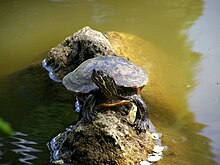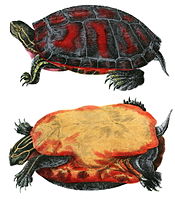
The red-eared slider or red-eared terrapin is a subspecies of the pond slider, a semiaquatic turtle belonging to the family Emydidae. It is the most popular pet turtle in the United States, is also popular as a pet across the rest of the world, and is the most invasive turtle. It is the most commonly traded turtle in the world.

The chicken turtle is a turtle native to the southeastern United States. It is the only extant member of the genus Deirochelys and is a member of the freshwater marsh turtle family Emydidae. The chicken turtle's scientific name refers to its extremely long neck and distinctive net-like pattern on its upper shell. There are three regionally distinct subspecies, which are thought to have evolved when populations became separated during periods of glaciation. These subspecies can be distinguished by their appearance; the western chicken turtle displays dark markings along the seams of its plastron, while the plastron of the Florida subspecies is a bright yellow or orange color. Fossil records show that the chicken turtle has been present in the region for up to five million years.

Pseudemys is a genus of large, herbivorous, freshwater turtles of the eastern United States and adjacent northeast Mexico. They are often referred to as cooters, which stems from kuta, the word for turtle in the Bambara and Malinké languages, brought to America by enslaved people from Africa.
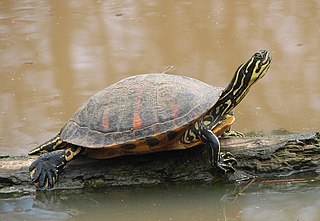
The Florida red-bellied cooter or Florida redbelly turtle is a species of turtle in the family Emydidae.

The Alabama red-bellied cooter or Alabama red-bellied turtle, is native to Alabama. It belongs to the turtle family Emydidae, the pond turtles. It is the official reptile of the state of Alabama.

The Amboina box turtle or Southeast Asian box turtle is a species of Asian box turtle.

The Indian roofed turtle is a species of turtle in the family Geoemydidae. It can be distinguished by the distinct "roof" at the topmost part of the shell. It is found in the major rivers of South Asia. It is a common pet in the Indian Subcontinent.

The Plymouth red-bellied turtle, sometimes called the Plymouth red-bellied cooter, is a disjunct population of northern red-bellied cooter endemic to Massachusetts.

The spiny softshell turtle is a species of softshell turtle, one of the largest freshwater turtle species in North America. Both the common name, spiny softshell, and the specific name, spinifera (spine-bearing), refer to the spiny, cone-like projections on the leading edge of the carapace, which are not scutes (scales).
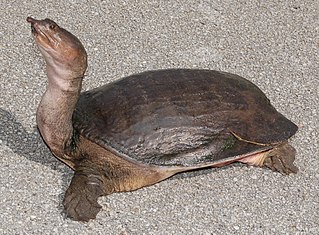
The Florida softshell turtle is a species of turtle in the family Trionychidae. The species is native to the Southeastern United States.

The wood turtle is a species of turtle endemic to North America. It is in the genus Glyptemys, a genus which contains only one other species of turtle: the bog turtle. The wood turtle reaches a straight carapace length of 14 to 20 centimeters, its defining characteristic being the pyramidal shape of the scutes on its upper shell. Morphologically, it is similar to the bog turtle, spotted turtle, and Blanding's turtle. The wood turtle exists in a broad geographic range extending from Nova Scotia in the north to Minnesota in the west and Virginia in the south. In the past, it was forced south by encroaching glaciers: skeletal remains have been found as far south as Georgia.

The river cooter is a species of freshwater turtle in the family Emydidae. The species is native to the central and eastern United States, but has been introduced into parts of California, Washington, and British Columbia.

The coastal plain cooter or Florida cooter is a species of large herbivorous freshwater turtle in the genus Pseudemys.

The Caspian turtle or striped-neck terrapin is a species of turtle in the family Geoemydidae (=Bataguridae), living in the eastern Mediterranean region from southwestern former USSR and central Iran to Saudi Arabia, Bahrain, Israel, and Lebanon, northward through Turkey to Bulgaria, and through Cyprus, Crete, and the Ionian Peninsula to former Yugoslavia.

The Cumberland slider, also called commonly the Cumberland turtle and Troost's turtle, is a subspecies of pond slider, a semiaquatic turtle in the family Emydidae. The subspecies is indigenous to the Southeastern United States.

The northern map turtle, also known as the common map turtle, is an aquatic turtle in the family Emydidae. It is endemic to North America.
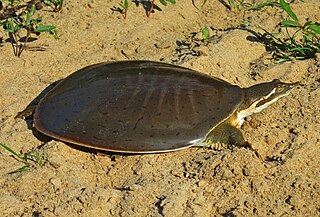
The smooth softshell turtle is a species of softshell turtle of the family Trionychidae. The species is endemic to North America.

The yellow-bellied slider is a land and water turtle belonging to the family Emydidae. This subspecies of pond slider is native to the southeastern United States, specifically from Florida to southeastern Virginia, and is the most common turtle species in its range. It is found in a wide variety of habitats, including slow-moving rivers, floodplain swamps, marshes, seasonal wetlands, and permanent ponds. Yellow-bellied sliders are popular as pets. They are a model organism for population studies due to their high population densities.

The peninsula cooter is a species of freshwater turtle in the genus Pseudemys. It is sometimes considered a subspecies of the coastal plain cooter when that turtle is not itself considered a subspecies of the river cooter.

The Suwannee cooter is a subspecies of turtle in the genus Pseudemys. It is a subspecies of the river cooter. The species is endemic to Florida, including in the Suwannee River.
